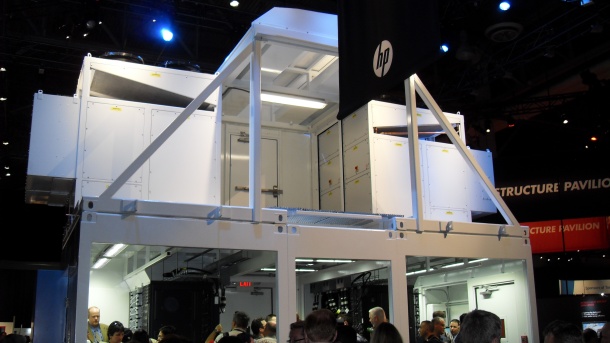HP unveils EcoPOD miniature datacentre

HP has introduced EcoPod, a containerised datacentre with a level of efficiency comparable to those run by Google, Facebook and other major companies, under the right circumstances.

HP has introduced a containerised datacentre called the 240a, promising a high power usage effectiveness rating. Photo credit: Jack Clark
The HP performance-optimised datacentre 240a, unveiled on Monday at HP Discover in Las Vegas, is a dense, containerised datacentre. It promises to cut the amount of money companies spend on powering the supporting infrastructure for their IT equipment, allowing their power expenditure to go progressively more on their IT hardware.
The EcoPod can achieve an annualised power usage effectiveness (PUE) rating of 1.05 in ideal circumstances, 1.1 to 1.15 in general circumstances, and 1.3 to 1.35 in extreme environments where no outside air can be used in cooling, according to HP. The company measures the PUE from the point where the power comes into the facility via the electricity from the substation, down to the individual server level.
"Really, it's a modular approach for any density or tier level," said Wade Vinson, a distinguished technologist at HP and a driving force behind the development of the EcoPod. "You don't have to be Google or Microsoft to reinvent your datacentre."
PUE metric
PUE is an industry-standard metric that reflects the amount of power that is used in IT, compared with what is used in supporting infrastructure. A PUE of 1.05 means that for every unit spent on power, .05 units are spent on the equipment to support the IT. Vinson estimates that in 80 percent of cities, it should be possible to run an EcoPod with a PUE of 1.15, though 1.05 can be achieved if sites are selected with an amenable, relatively cool environment.
By comparison, Google has reported an annualised PUE of 1.13 for the first quarter of 2011 across its datacentres, Facebook has a PUE of 1.07 and Rackspace a PUE of 1.7.
However, the PUE of 1.05 can only occur in ideal circumstances where the racks in the datacentre have been fully loaded with IT equipment. The datacentre also needs to be in a non-redundant power configuration — thereby saving on the power needed for backup infrastructure — and have an external ambient air temperature low enough for it to use a minimum amount of powered directed-expansion cooling, HP said.
"I would say what's broadly achievable is a PUE of 1.1 to 1.15, even in Houston," Vinson told ZDNet UK. He explained that this is possible if companies push the IT equipment to the limits of their design specifications, by running the servers at 25° C and in humidity ranging from 20 to 80 percent.
If customers are not able to use external ambient air, due to the temperature being too high or the filtration process too costly, then the PUE will rise. "We say about a 1.3, 1.35 if you want a [cold] meatlocker," Vinson said.
Adaptive cooling
As expected, the EcoPod has a cooling system that uses a combination of powered direct expansion cooling and outside ambient air. HP calls it an 'adaptive cooling' system, as special software automates the speed and number of the container's 24 fans that are turned on at any one time to make sure power is being used effectively.
HP presented the EcoPod datacentre in cake form at the launch in Las Vegas. Photo credit: Jack Clark
"The EcoPod always monitors the inlet temperatures, the IT gear and the workloads inside," said Mark Potter, general manager of HP's industry standard servers and software unit. "We're able to mix free air from the outside with assisted air where we've cooled it, and we constantly optimise this solution."
Because of the adaptable cooling system, Vinson is confident that the containerised EcoPods can demonstrate competitive PUEs wherever they are deployed. "Our entire architecture was about trying to be energy efficient," he said, explaining that the device has been tested in snow, in humid environments and in environments with high levels of particles in the air.
EcoPod specs
The EcoPod is the third generation of HP's Pod family. Unlike the other Pods, the 240a cannot be stacked on top of other containers, due to its overhead air vents and fans.
Each EcoPod can support 44 racks, each of which consists of 50U of space, so the datacentre has a capacity of 2,200 racks. Each rack can support a density of around 44KW. In a disaster-redundant power configuration, the facility will draw down 1.15MW of power, or 2.3MW in a non-redundant configuration.
"This is equivalent [density] to a 10,000-square-foot datacentre in 900 square feet," Mark Potter, HP's head of industry standard services and storage, said.
The datacentres are shipping to selected customers at the moment, but will become generally available to buy in North America in the fourth quarter and in Europe, Latin America and the Middle East early in 2012. A non-redundant EcoPod should sell for around $5m (£3.04m), while a Tier 3 one with a 1.2MW redundant power supply should sell for around $8.3m, Potter said. They will be manufactured in HP's PodWorks factories in Houston, Texas, and Erskine, Scotland.
When it comes to HP's own cloud services, they are all currently run from standard datacentres. However, Potter told ZDNet UK to "stay tuned" when asked whether the company would run its own datacentres off the new EcoPods. "It's a good solution for HP," he said.
The main competitor for the EcoPod is Microsoft's ITPAC range of containerised datacentres. When asked whether HP had collaborated with Microsoft at a technical level to implement the free cooling aspect of the EcoPod, which bears similarities to Microsoft's techniques used in the ITPAC, Vinson told ZDNet UK that many of the Microsoft team who worked on the ITPAC had come from inside HP and had moved over.
Get the latest technology news and analysis, blogs and reviews delivered directly to your inbox with ZDNet UK's newsletters.